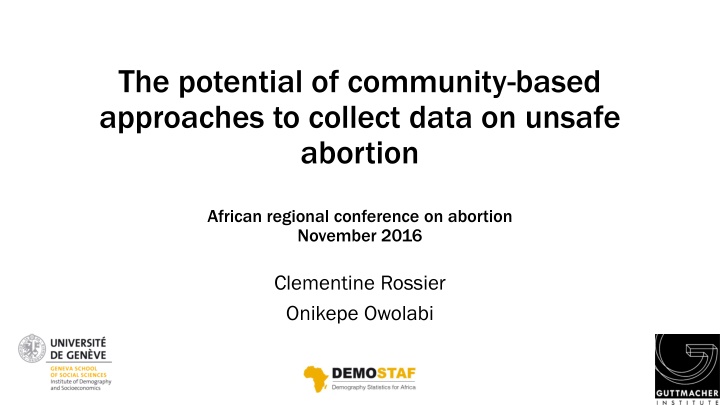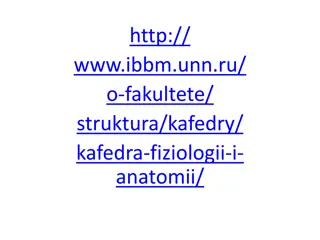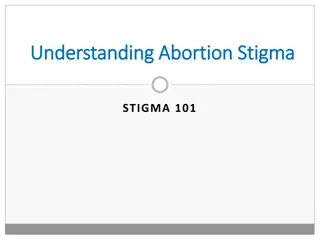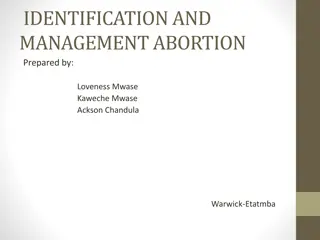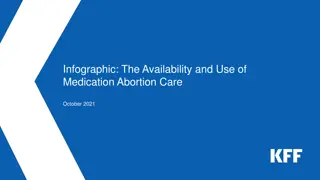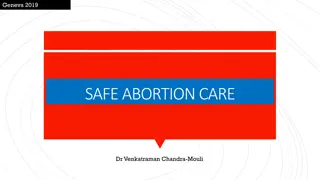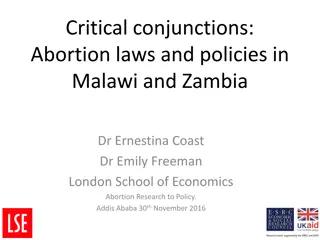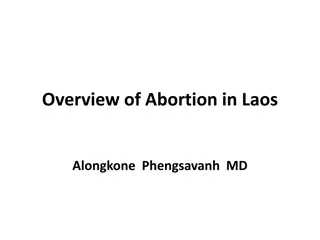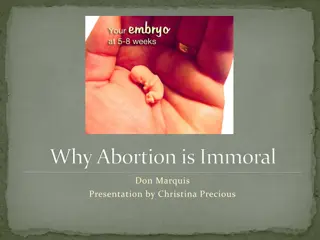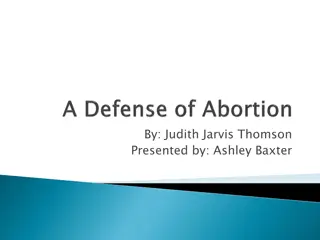Community-Based Approaches for Data Collection on Unsafe Abortion
Explore the potential of community-based approaches for collecting data on unsafe abortions, highlighting the changing landscape of induced abortions and the importance of safe medical standards. Learn about methods to obtain population-level indicators preceding and following abortions, including audio computer-assisted self-interviews and anonymous third-party reporting. Discover proposed methods like ATPR and respondent-driven sampling for collecting data on abortion safety at the population level.
Download Presentation

Please find below an Image/Link to download the presentation.
The content on the website is provided AS IS for your information and personal use only. It may not be sold, licensed, or shared on other websites without obtaining consent from the author.If you encounter any issues during the download, it is possible that the publisher has removed the file from their server.
You are allowed to download the files provided on this website for personal or commercial use, subject to the condition that they are used lawfully. All files are the property of their respective owners.
The content on the website is provided AS IS for your information and personal use only. It may not be sold, licensed, or shared on other websites without obtaining consent from the author.
E N D
Presentation Transcript
The potential of community-based approaches to collect data on unsafe abortion African regional conference on abortion November 2016 Clementine Rossier Onikepe Owolabi
How women obtain induced abortions has changed since significantly since the definition of unsafe abortion was proposed. Mifepristone Mifepristone The persons, skills and medical standards considered safe in the provision of abortion are different for medical and surgical abortion and also depend on the duration of the pregnancy. What is considered safe should be interpreted in line with current WHO technical and policy guidance. (24) The termination of an unintended pregnancy either by persons lacking the necessary skills or in an environment lacking the minimum medical standards or both. (23) 2000 2000 2010 2010 1990 1990 1980 1980 2015 World Health Organization. The prevention and management of unsafe abortion: report of a technical working group, Geneva, 12-15 April 1992. Geneva: World Health Organization (WHO); 1993; Ganatra, Bela, et al. "From concept to measurement: operationalizing WHO's definition of unsafe abortion." Bulletin of the World Health Organization 92.3 (2014): 155-155.
For future measurements of abortion safety- A multidimensional scale Sedgh, Gilda, et al. "Insights from an expert group meeting on the definition and measurement of unsafe abortion." International Journal of Gynecology & Obstetrics (2016).
How can we get population level indicators of the processes preceding and following abortions? Audio computer assisted self- interviews (ACASI Self-report Randomized-response technique (RRT) Sealed envelope method (SEM) Community based methods LIST experiment Anonymous third party reporting (ATPR)/Best friend approach Network scale-up methods Phillips AE et al. A systematic review and meta analysis of quantitative interviewing tools to investigate self reported HIV and STI associated behaviours in low and middle income countries Int Journal of Epidemiology 2010 39(6):1541-55
Applying indirect community based methods to collect population level data on abortion safety Proposed methods of interest include: ATPR/Best friend approach Network scale-up method Respondent driven sampling
Anonymous Third Party Reporting (ATPR) Assumptions In certain contexts women confide in their friends about their abortions especially where access to abortions is restricted Women are more comfortable reporting about their friends abortions anonymously Method Survey a representative sample of women in the population (Sample 1) Ask them to list out their close female relations (Sample 2) Ask about abortion practices and the process for sample 2 Has been tested in Burkina Faso, Zambia and India*
Limitations with solutions: Representativeness of sample 2 (stratify sample 2) Popularity bias (weight by indegree) Limitations yet to solve: No uncertainty intervals Comparison with other data possible but no gold standard for validation Quality of detailed information around the abortion process is uncertain Helleringer S PAA 2012. Do third party reports improve the measurement of sensiitive behavior? A validation study using social networks and HIV validation data.
Recent developments in the network scale-up method How to validate estimates internally How to calculate uncertainty intervals Developed to count rare events known to all e.g. earthquake victims in Mexico Method estimates two things: (i)The number people who have experienced the rare event (ii) The total number of people known e.g. 100 in the US, 308 in Iran Statistical approaches to estimating uncertainty have been developed It includes internal validation of the final estimate by testing the procedure for known counts in the population as part of the method Bernard HR, Hallett T, Iovita A, Johnsen EC, Lyerla R, McCarty C, et al. Counting hard-to-count populations: the network scale-up method for public health. Sex Transm Infect. 2010;86(Suppl 2):ii11- i15.; Rastegari A, Haji-Maghsoudi S, Haghdoost A, Shatti M, Tarjoman T, Baneshi MR. The estimation of active social network size of the Iranian population. Glob J Health Sci. 2013;5(4):217 27.
However, very recent paper on this methodology limits the network to close relations (people you eat with) with even better results =ATPR =ATPR Limitations Not adapted to stigmatized behaviour e.g. its application in Iran entailed a far fetched multiplier The new iteration has not taken into account the biases linked with a sample of close relations (representativeness and in-degree) It has not collected data on characteristics or processes of the population, just counts. Feehan DM, Umubyeyi A, Mahy M, Hladik W, Salganik MJ. Quantity Versus Quality: A Survey Experiment to Improve the Network Scale-up Method. Am J Epidemiol. 2016;183(8):747 57.
Towards an improved ATPR/Network Scale-up for close relations Apply the statistical methods of the network scale-up to estimate uncertainty intervals Conduct internal validation of known population values to assess final estimate However, the quality of data collected on a third party remains uncertain
Respondent Driven Sampling How to improve quality on information about the abortion process Developed to collected detailed data on highly sensitive behaviour by Douglas Heckathorn in 2002 It has been extensively applied for many stigmatized behaviours including abortion recently Method (i)It starts with a limited number of seed respondents who have experienced the event and they recruit network members who have also experienced the event .. Heckathorn DD. Extensions of respondent-driven sampling: Analyzing continuous variables and controlling for differential recruitment. Sociol Methodol. 2007;37:151 207.
The data of quality collected is higher because interviews are with a respondent who has volunteered to be recruited. Statistical approaches and software to ensure estimates are population representative have been developed and tested extensively The method cites no additional need for validation Limitations Ultimately the method is limited to local data gathering It may be difficult to implement in a small/rural setting due to anonymity concerns especially for some behaviours
Thank You for Listening Thank You for Listening Questions???
